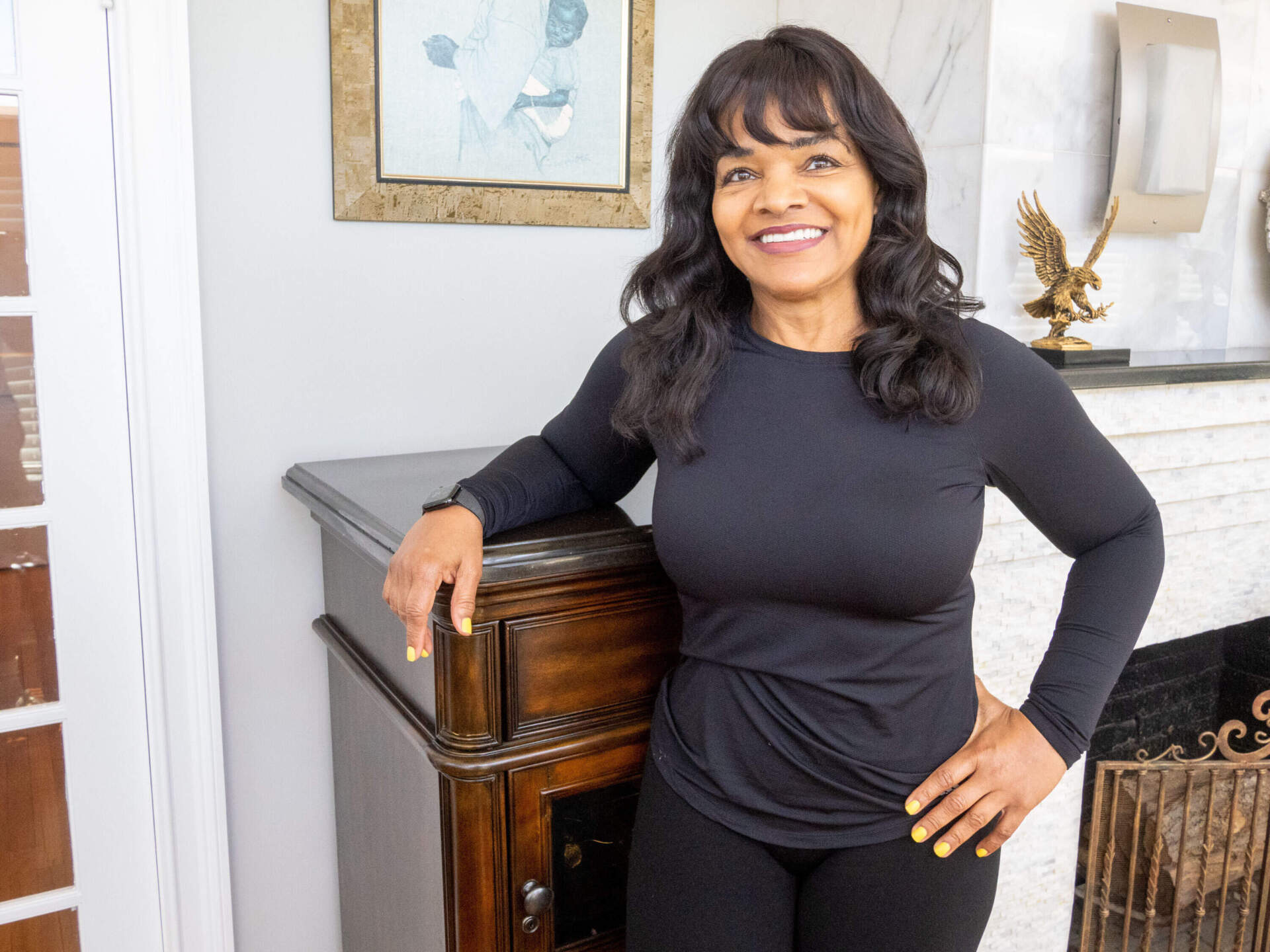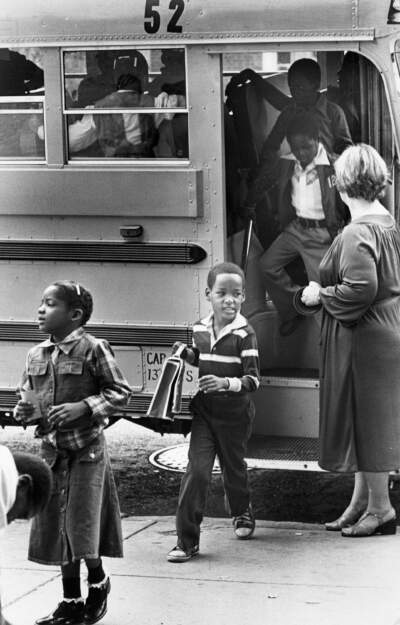Advertisement
Busing's legacy in Boston, 50 years later
How Boston's Eliot School desegregated — and resegregated
Resume
By many measures, the Eliot K-8 Innovation School is a notable bright spot for Boston Public Schools. Its students routinely — often dramatically — beat the state average on MCAS scores. Scattered across three buildings in the city's North End, kids at the school have access to hands-on learning, enrichment programs, art, music and theater offerings, even classes in Italian.
The Eliot’s newest building, the Upper School for grades 5 to 8, opened in fall 2019 following a two-year, $20 million construction project. It sits on the mouth of the Charles River, with a view of Charlestown and the USS Constitution. It’s flanked by new playgrounds and ballfields, where — after school in April — dozens of students and their families gathered on the lawn to gaze at the partial solar eclipse.
Many wore eclipse glasses provided by the Friends of The Eliot School, a parent-run nonprofit with nearly $1 million in assets as of 2022.

Parent Dan Ryan, a Democratic state representative for Suffolk County whose district includes nearby Charlestown, was there with his daughter, Audrey, and her two friends, Maddix and Peyton, before the girls’ soccer game. As they looked up at the sky, the girls gushed about the Eliot, including the quality of education, the technology and community.
“The teachers are very helpful,” Audrey said. “Whenever we’re in need of help, they’re always there.”
Even for Boston, the Eliot has a long history — it proudly counts Paul Revere and Samuel Adams among its alumni.
But its past few decades have been complicated: the school nearly closed before its revival, moving from desegregation to resegregation, pushed on by parent preference, district policy and Boston’s deepening inequality.
One of the city’s best-resourced and sought-after schools, the Eliot is also disproportionately made up of white students. Across all 119 Boston public schools, the Eliot has the second-highest percentage of white students, at 63%, and the lowest percentage of Black and Latino students, of 6% and 14%, respectively, according to state enrollment data.
The school stands as an illustration of how — 50 years after Boston was ordered to desegregate its schools by busing students across town — the vestiges of race, class and geography still weigh on the city. It also reflects other factors that play into the persistent stratification, including parent fundraising, residential segregation and the district’s school choice policy — known as the home-based assignment policy — enacted in 2013 to offer families access to good schools close to home.
Advertisement
The resegregating trend is driven in part by a perception that only a handful of BPS schools are safe, effective and high-quality, according to Edith Bazile, a longtime advocate for Black families and educators.
"And many parents unfortunately assess whether a school is high-achieving based upon the demographics of race,” she said.
Barely 15 years ago, the Eliot was a small, one-building school nestled in the heart of the North End. In a legacy of the busing era, many students came from Dorchester, Hyde Park and Mattapan, Bazile said.
A former classroom teacher, Bazile led professional development for special education teachers in Boston Public Schools, including at the Eliot, from 2000 to 2010.
In 2008, two-thirds of Eliot’s students were Black and Latino. Seventy percent of its students came from low-income households.
At the same time, the school wasn't producing the results anyone wanted. Eighty percent of its third graders were failing the English section of the MCAS.
After years of poor performance, district officials seriously considered closing the school.
It fell to staff to implement a rapid turnaround, according to Bazile.
“The challenge was, how do we improve the literacy rate of students, particularly students who are immigrants, who speak a second language, how do we support them?” she said.

According to Bazile, Eliot’s staff took important steps to bring in new programs, many of which have endured today: a renewed focus on early literacy, a move to include students with disabilities in general classrooms, stepped-up offerings in the arts.
Between 2007 and 2011, under the leadership of principal Traci Walker Griffith, three times as many Eliot students passed the MCAS. By 2012, the school boasted a waiting list nearly as long as its 300-seat enrollment, according to the local news blog North End Waterfront.
And all of this success came as the school largely maintained its diverse student body.
But that was about to change.
Busing and desegregating the Eliot
When Judge W. Arthur Garrity issued his desegregation order on June 21, 1974, he said it was meant to address “distinct racial clusters” within Boston’s schools. Relative to the overall composition of the district, many schools like the Eliot were disproportionately white, while others were disproportionately Black.

Garrity said that the effect was deliberate: the district’s educational zones were drawn to produce, in his words, “nearly the maximum possible amount of racial isolation” citywide and in a band from Roxbury to South Boston.
His desegregation order was meant to address the disproportionate population of Black and white kids in schools. On his order, buses mobilized across the city, some of them taking Black and Latino students to the Eliot in the white, Italian stronghold of the North End.
That order would hold until 1988.
By 1989, a new “controlled choice” assignment plan began. The city was divided into three zones, and the schools in each had to reflect the “racial balance” of the zone. Students were assigned to schools using a lottery system.
Ten years later, the Boston school committee voted that the city was no longer required to maintain racial balance at the school level.
Despite those changes, the Eliot remained a diverse learning environment, and fought its way back from the verge of closure to become one of the top schools in the city.
School choice and a loss of diversity
In 2013, under former mayor Thomas Menino, Boston enacted a new school choice system that sought to offer families access to good schools closer to their homes.
It was part of Menino’s effort to attract middle- and upper-class families back into the Boston Public School system. After decades of white flight into the suburbs or private schools preceding and during the busing era, Boston's schools went from majority white in 1973 to a district with just 13% white students by 2013 (indeed, even today white students comprise less than 15% of the district's student population).
"Many parents unfortunately assess whether a school is high-achieving based upon the demographics of race."
Edith Bazile
As the North End and Charlestown began to gentrify, Menino hoped new arrivals would choose the Eliot for their children. Under his tenure, the city invested millions in building repairs. They held open houses, where parents came to see the school as a diamond in the rough. Over the next 20-plus years, white families returned to the school and now dominate its student body.
The Eliot has become one of the most in-demand K to 8 schools: with about 800 seats today, it has fewer than one space open for every five interested families for the upcoming school year. Given the use of home address in the school choice algorithm, its students tend to come from the neighborhoods around the school. Census data show that in Charlestown, the Back Bay, South Boston and the North End itself the median household income has doubled, to as high as $186,000, since 2000.
Under the home-based assignment policy pushed by Menino, families in the southern parts of the city, such as Hyde Park or Mattapan, are unlikely to be placed in the Eliot.
“If you live in Mattapan, you have about a 5% chance of going to a high-achieving school," Bazile said. "If you live in the Fenway, you have almost a hundred percent chance.”
Griffith, the Eliot principal, and members of its governing board declined to comment for this article. WBUR requested several times to pay a visit to the Eliot, but district officials did not respond.
Without a doubt, the Eliot is a warm, welcoming and high-achieving school today. But Bazile and others wonder if Boston can give more kids the Eliot experience closer to home.
This segment aired on June 18, 2024.
